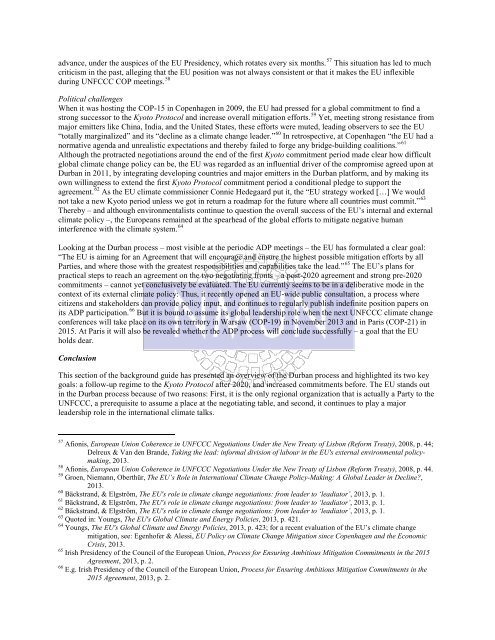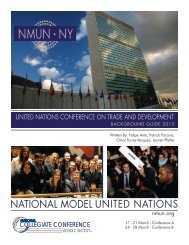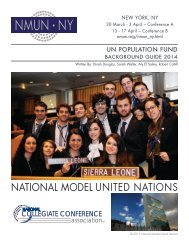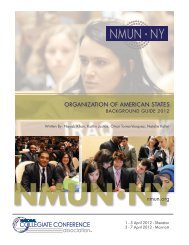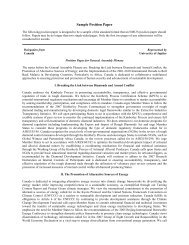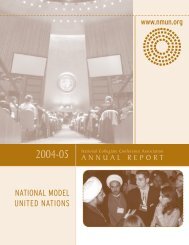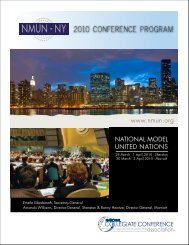NMUN • KOREA - National Model United Nations
NMUN • KOREA - National Model United Nations
NMUN • KOREA - National Model United Nations
Create successful ePaper yourself
Turn your PDF publications into a flip-book with our unique Google optimized e-Paper software.
advance, under the auspices of the EU Presidency, which rotates every six months. 57 This situation has led to much<br />
criticism in the past, alleging that the EU position was not always consistent or that it makes the EU inflexible<br />
during UNFCCC COP meetings. 58<br />
Political challenges<br />
When it was hosting the COP-15 in Copenhagen in 2009, the EU had pressed for a global commitment to find a<br />
strong successor to the Kyoto Protocol and increase overall mitigation efforts. 59 Yet, meeting strong resistance from<br />
major emitters like China, India, and the <strong>United</strong> States, these efforts were muted, leading observers to see the EU<br />
“totally marginalized” and its “decline as a climate change leader.” 60 In retrospective, at Copenhagen “the EU had a<br />
normative agenda and unrealistic expectations and thereby failed to forge any bridge-building coalitions.” 61<br />
Although the protracted negotiations around the end of the first Kyoto commitment period made clear how difficult<br />
global climate change policy can be, the EU was regarded as an influential driver of the compromise agreed upon at<br />
Durban in 2011, by integrating developing countries and major emitters in the Durban platform, and by making its<br />
own willingness to extend the first Kyoto Protocol commitment period a conditional pledge to support the<br />
agreement. 62 As the EU climate commissioner Connie Hedegaard put it, the “EU strategy worked […] We would<br />
not take a new Kyoto period unless we got in return a roadmap for the future where all countries must commit.” 63<br />
Thereby – and although environmentalists continue to question the overall success of the EU’s internal and external<br />
climate policy –, the Europeans remained at the spearhead of the global efforts to mitigate negative human<br />
interference with the climate system. 64<br />
Looking at the Durban process – most visible at the periodic ADP meetings – the EU has formulated a clear goal:<br />
“The EU is aiming for an Agreement that will encourage and ensure the highest possible mitigation efforts by all<br />
Parties, and where those with the greatest responsibilities and capabilities take the lead.” 65 The EU’s plans for<br />
practical steps to reach an agreement on the two negotiating fronts – a post-2020 agreement and strong pre-2020<br />
commitments – cannot yet conclusively be evaluated. The EU currently seems to be in a deliberative mode in the<br />
context of its external climate policy: Thus, it recently opened an EU-wide public consultation, a process where<br />
citizens and stakeholders can provide policy input, and continues to regularly publish indefinite position papers on<br />
its ADP participation. 66 But it is bound to assume its global leadership role when the next UNFCCC climate change<br />
conferences will take place on its own territory in Warsaw (COP-19) in November 2013 and in Paris (COP-21) in<br />
2015. At Paris it will also be revealed whether the ADP process will conclude successfully – a goal that the EU<br />
holds dear.<br />
Conclusion<br />
This section of the background guide has presented an overview of the Durban process and highlighted its two key<br />
goals: a follow-up regime to the Kyoto Protocol after 2020, and increased commitments before. The EU stands out<br />
in the Durban process because of two reasons: First, it is the only regional organization that is actually a Party to the<br />
UNFCCC, a prerequisite to assume a place at the negotiating table, and second, it continues to play a major<br />
leadership role in the international climate talks.<br />
57 Afionis, European Union Coherence in UNFCCC Negotiations Under the New Treaty of Lisbon (Reform Treaty), 2008, p. 44;<br />
Delreux & Van den Brande, Taking the lead: informal division of labour in the EU's external environmental policymaking,<br />
2013.<br />
58 Afionis, European Union Coherence in UNFCCC Negotiations Under the New Treaty of Lisbon (Reform Treaty), 2008, p. 44.<br />
59 Groen, Niemann, Oberthür, The EU’s Role in International Climate Change Policy-Making: A Global Leader in Decline?,<br />
2013.<br />
60 Bäckstrand, & Elgström, The EU's role in climate change negotiations: from leader to ‘leadiator’, 2013, p. 1.<br />
61 Bäckstrand, & Elgström, The EU's role in climate change negotiations: from leader to ‘leadiator’, 2013, p. 1.<br />
62 Bäckstrand, & Elgström, The EU's role in climate change negotiations: from leader to ‘leadiator’, 2013, p. 1.<br />
63 Quoted in: Youngs, The EU's Global Climate and Energy Policies, 2013, p. 421.<br />
64 Youngs, The EU's Global Climate and Energy Policies, 2013, p. 423; for a recent evaluation of the EU’s climate change<br />
mitigation, see: Egenhofer & Alessi, EU Policy on Climate Change Mitigation since Copenhagen and the Economic<br />
Crisis, 2013.<br />
65 Irish Presidency of the Council of the European Union, Process for Ensuring Ambitious Mitigation Commitments in the 2015<br />
Agreement, 2013, p. 2.<br />
66 E.g. Irish Presidency of the Council of the European Union, Process for Ensuring Ambitious Mitigation Commitments in the<br />
2015 Agreement, 2013, p. 2.


